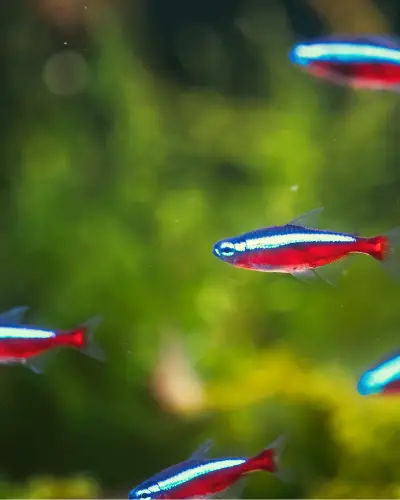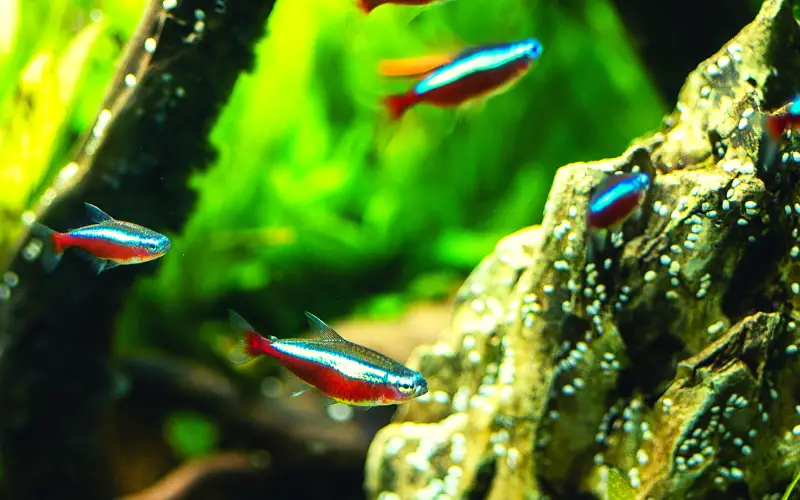Neon tetras: those vibrant, shimmering jewels of the freshwater aquarium world. But before you bring home a handful of these beauties, there’s a crucial question to answer: how many neon tetras should be kept together?
The answer may surprise you! It’s not just about filling your tank with color; it’s about creating a thriving community where these social aquarium fish can truly shine.
In the wild, neon tetras navigate the intricate Amazonian waterways in dazzling schools, their collective movement a mesmerizing spectacle.

Recreating this sense of community in your aquarium is vital to unlocking their natural behaviors and reducing stress. So, forget the myth of the solitary fish; neon tetras thrive in numbers!
Join us as we delve into the fascinating world of neon tetras, exploring the ideal group size, tank requirements, and tips for creating a harmonious aquatic environment where your neon companions will flourish.
Table of Contents
ToggleHow Many Neon Tetras Should Be Kept Together in A Tank?
To ensure neon tetras thrive, it’s recommended to keep them in schools of at least six or more, as they are social fish that do best in groups. Neon tetras also prefer water temperatures between 72-78°F and slightly acidic water with a pH between 5.5-7.
Additionally, they thrive in heavily planted tanks with plenty of hiding spots and dim lighting. Regular water changes and a balanced diet of high-quality fish flakes, pellets, and frozen or live foods will also help ensure their health and well-being.

It is important to avoid keeping neon tetras with aggressive or larger fish species, as they are relatively small and can easily become targets for bullying or predation. They are peaceful community fish that do best when kept with other small, non-aggressive species.
Maintaining good water quality is critical to neon tetras’ good health and longevity. Regular water testing and maintenance, including removing uneaten food or waste from the tank, will help keep their environment clean and healthy.
Lastly, providing a well-balanced diet with plant-based and protein-rich foods will help ensure neon tetras receive all the necessary nutrients for optimal health and vibrancy. By following these guidelines and providing a suitable environment, neon tetras can thrive and bring beauty and color to any freshwater aquarium.
Neon Tetra Fish – A Detailed Overview:
The neon tetra (Paracheirodon innesi) is an iconic freshwater fish prized for its dazzling colors and peaceful temperament. A staple in the home aquarium hobby, these tiny fish bring a vibrant splash of life to any tank.
Neon tetras are schooling fish that thrive in groups, originating in the blackwater streams of the western Amazon basin in South America.
Their slender, torpedo-shaped bodies reach up to 1.5 inches long. They are adorned with two eye-catching horizontal stripes: a brilliant electric blue that runs along the body from the nose to the adipose fin and a fiery red stripe that begins mid-body and extends to the tail fin. Their small fins and semi-transparent bodies add to their delicate charm.
– Living in Harmony: The Neon Tetra Community
In their natural habitat, neon tetras live in large schools to protect themselves from predators. This social behavior translates well to the aquarium, where they should be kept in groups of at least six, though ideally more. A shoal of neon tetras darting around the tank in perfect unison is a mesmerizing sight.
– Thriving in the Right Environment
Neon tetras are relatively easy to care for, making them ideal for beginner aquarists. They prefer slightly acidic water conditions (pH 6.0-7.0) and a temperature range of 68-82°F. They are omnivores and will readily accept a variety of flake foods, brine shrimp, and bloodworms.
– Breeding Neon Tetras
Breeding neon tetras in captivity is a bit more challenging. It requires a separate breeding tank with specific water parameters and a dense cover of plants for the eggs.
– A Vibrant Addition to Your Aquarium
With their stunning looks, peaceful nature, and relatively low maintenance requirements, neon tetras are perfect for a lively and colorful freshwater aquarium. So, if you’re looking for a way to add a touch of the tropics to your home, consider welcoming a school of neon tetras!
Neon Tetra Health & Aquarium Tank Requirements
Neon tetras are one of the most popular fish species in the aquarium hobby. They are peaceful fish that swim together and make a beautiful addition to any community tank.
When setting up a tank for Neons, it is crucial to consider their health and aquarium requirements. Neon tetras need at least a 10-gallon tank, with 10 gallons of water for every 1 inch of fish.
A 20 gallon tank is recommended if you want to keep around four tetras and other species of fish. Good filtration is crucial to maintaining water quality and keeping the fish healthy.
Cycle the tank before adding any fish and provide adequate live plants and decorations for the Neons to swim around in. Avoid overstocking the tank and be mindful of the bioload of your fish tank inhabitants to avoid neon tetra disease.
Compatible Neon Tetra Tank Mates
Neon tetras are peaceful fish that can thrive with various tank mates as long as their tank mates are calm and not too large. Here are some compatible neon tetra tank mates:
Other schooling fish:
- Cardinal tetras: These fish are similar to neon tetras in size, temperament, and water requirements. They can school together beautifully.
- Rummy nose tetras: These tetras are slightly larger than neon tetras but still peaceful. Their distinctive red “nose” adds a pop of color to the tank.
- Harlequin rasboras: These small, colorful fish are another peaceful option for a community tank with neon tetras.
Corydoras catfish:
- Corydoras catfish are bottom-dwelling fish that are excellent scavengers. They will help keep your tank clean and peaceful towards neon tetras.
Dwarf Gouramis:
- Dwarf Gouramis are another peaceful option for a community tank with neon tetras. However, it is essential to choose a quiet dwarf gourami variety, such as the honey gourami or the dwarf paradise gourami.
Shrimp:
- Shrimp can be a good option for a community tank with neon tetras, as long as the neon tetras are not too large. Cherry shrimp and ghost shrimp are both popular choices.
Things to avoid:
- Large fish that could eat neon tetras, such as cichlids or barbs.
- Fin nippers, such as some tetras and barbs.
- Fish with very different water requirements than neon tetras.
When choosing tank mates for your neon tetras, it is essential to do your research to make sure that the fish are compatible. It is also important to consider the tank size. Neon tetras are relatively small fish, so they need to be kept in a tank of at least 10 gallons. With some planning, you can create a beautiful, thriving community tank for your neon tetras.
Commonly Asked Questions about How Many Neon Tetras per Gallon Tank (FAQs)
Is it OK to have 4 neon tetras?
Are 4 neon tetras enough? Four neon tetras are borderline. Ideally, neon tetras need a school of 6-10 for comfort. This reduces stress and mimics their natural behavior.
Can I keep 2 neon tetras?
It could be better to keep only two neon tetras. They are schooling fish and thrive in groups of 6 or more for comfort and stress reduction.
How many neon tetras per tank?
How many neon tetras per gallon tank? Aim for at least six or more per tank for a thriving neon tetra community, as their social nature requires a group environment.
Are 5 neon tetras enough?
While five neon tetras can coexist, given their social nature, they’ll be happier and exhibit more natural behaviors in larger groups of six or more.
Can neon tetras live in groups of 4?
Neons can survive in groups of four but may experience stress and exhibit less vibrant colors due to their preference for larger schools.
How much space do 4 neon tetras need?
While four tetras can technically live in a 5-gallon tank, a 10-gallon tank is ideal. They are schooling fish and thrive with more space to swim in!
Can I have 8 neon tetras, 4 panda corys and one betta in a 20-gallon tank?
Maybe, but there’s a chance of betta aggression. Twenty gallons is enough space, but bettas can be territorial. Research peaceful bettas and add plenty of hiding spots for the tetras.
Is it okay for a goldfish to be kept with neon tetras?
No, neon tetras and goldfish are poor tank mates. Goldfish grow large and may bully or even eat tetras. Their differing temperature needs and goldfish’s waste production can lead to aggression and stress for both fish.
Do Neons need a filter?
Yes, neon tetras need a filter! A filter keeps the water clean, removes waste, and reduces aggression in neon tetras by minimizing resource competition.
How many neon tetras are in 10 gallon tank with a mystery snail?
While the “one inch per gallon” rule suggests ten tetras, it’s best to stay under that for good water quality. Aim for 6-8 neon tetras with a mystery snail in a 10 gallon tank.
Final Thoughts
How many neon tetras per gallon? By understanding the social needs of neon tetras and providing them with the right environment, you’ll witness their true colors shine. Remember, a spacious tank with ample hiding spots and gentle filtration is crucial to their well-being. Introduce compatible tank mates, maintain pristine water conditions, and offer a varied diet to ensure your neon companions thrive.
So, how many neon tetras should be kept together? The magic number is six or more! By embracing their schooling instincts, you’ll create a vibrant, dynamic ecosystem where these mesmerizing fish can live their best lives, adding a splash of brilliance to your aquarium and a touch of wonder to your everyday routine.
Recommended posts
- Are Neon Tetras Hardy Fish: 7 Secrets to Tank-Raising Bliss!
- The Ideal Neon Tetra Temperature: (Comprehensive Care Guide)
- How Long Do Neon Tetras Live: (Unlock Their HIDDEN Lifespan)
- How Big Do Neon Tetras Get: (Size Guide for Neon Fish Species)
- How Many Tetra Fish in a 10 Gallon Tank (Expert Stocking Guide)




